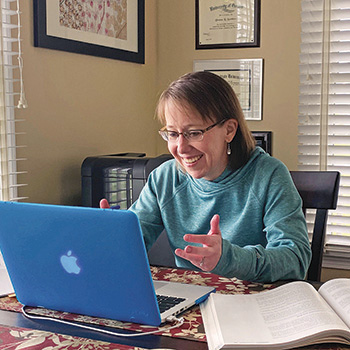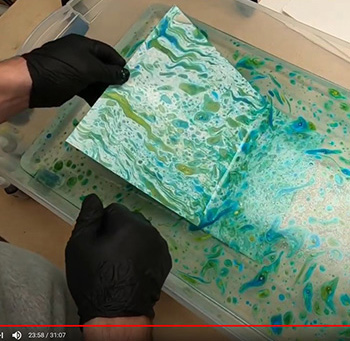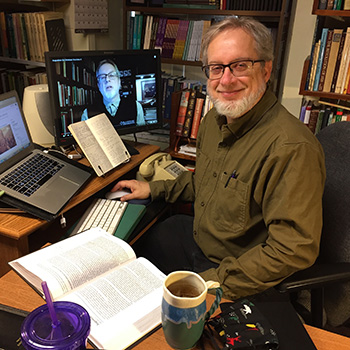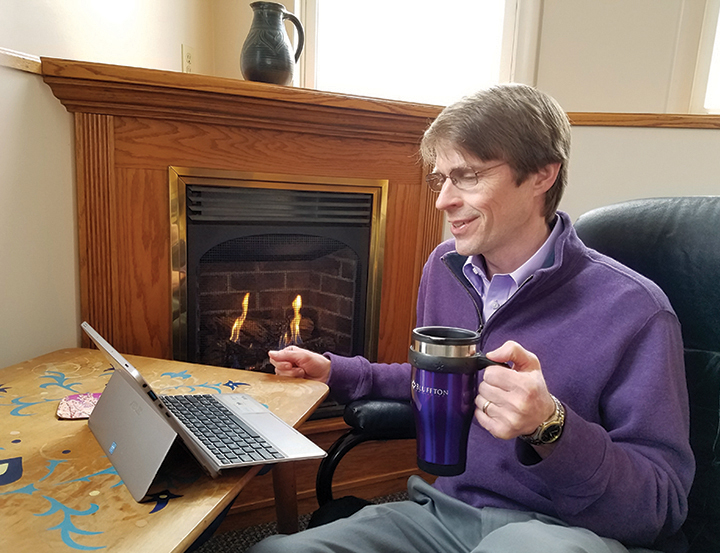
Dr. Deanna Barthlow-Potkanowicz put together two remote-teaching setups at her house. Her husband is a professor at Ohio Northern University

Andi Baumgartner demonstrates a marbling printmaking technique in this screenshot from a video made for Printmaking: Alternative Digital Print.

Dr. Gerald Mast continued to teach from Riley Court. His setup included two monitors which helped him use Zoom effectively.
Relationships Key to Remote Learning

For students, faculty and staff at Bluffton, the hardest part about transitioning to remote learning may have also enhanced its success. Pandemic health and safety measures meant students couldn’t learn in physical community, but the strength of relationships forged on campus before the shutdown, endured.
June 2020
“Bluffton’s leadership emphasized from the beginning of this crisis that our primary focus should be on supporting one another and our students,” said Dr. Gerald Mast, professor of communication. “I believe our students stayed engaged during this difficult time because of the relationships they have with each other and with faculty and staff. Resilience is something we achieve together, in community.”
On March 10, Ohio’s governor mandated institutions of higher education transition
to remote learning. By March 16, final in-person classes were held, faculty workshops
on the use of helpful technology (including the videoconferencing platform Zoom and
course management system Moodle) took place and remote instruction began. Many Bluffton
faculty were already familiar with the tools, having used them in their regular coursework
or while teaching adult and graduate classes.
“I encouraged professors to try some approaches with which they were comfortable right away and then, over some days, to add additional elements to their remote teaching,” explained Dr. Lamar Nisly, vice president and dean of academic affairs. “There were some challenges. First, developing a wellstructured remote course takes time. We didn’t have that luxury. Second, all of us—students and faculty/staff—are at Bluffton because we love face-to-face interaction.”
For some students, access to high-speed internet or a computer was also a challenge—especially with parents working at home or having siblings who were also completing remote learning assignments for their K-12 or college classes. Many students relied heavily on their smartphones.
“I quickly learned how to use the Zoom app on my own phone so I could show students how to use the app. Other students drove to fast-food places with internet access and would join class from the parking lot because their home internet access was too weak,” said Mast. “During class students who lost access would often text a classmate who would give live updates to me and the class on their progress in reconnecting.”
Sometimes, the challenges were more humorous in nature.
“There were some issues with technology, including my home WiFi tending to fade out if my wife turned on the microwave during class,” said Dr. Jeff Gundy, professor of English. “One student ended up sharing his earbuds with his little sister all through one class period—apparently she found me amusing!”
And sometimes challenges were thwarted because of increased communication and outreach provided by faculty.
“When I see students in a classroom, I can often pick up on who is struggling or falling behind,” explained Dr. Deanna Barthlow-Potkanowicz, assistant professor of psychology. “But, once we moved online, I encouraged them more frequently to reach out if they were confused or had questions because I didn’t have my usual cues available to me.”
In some instances, Zoom connections weren’t practical for remote instruction, so professors adapted.
“For applied lessons, which are one-on-one, we started with Zoom sessions, but those were difficult—the mics on student computers weren’t great for the frequencies and internet speeds varied a lot,” said Dr. Roy Couch, associate professor of music. “We had better success having students record pieces and send them to us. Then we would meet via Zoom to provide feedback.”
Similar challenges took place in the art department.
“I ended up pre-recording demonstrations and lectures in video form, and uploading the file for private YouTube access,” said Andreas Baumgartner ’08, associate professor of art. “This approach was helpful for students in a number of ways—most notably students were able to repeatedly watch video content in order to fully pick up on the procedural steps.”
Each professor determined the best approach for holding their classes. Many remote sessions were held during the same timeframes they were held on campus. Other classes transitioned to an asynchronous model, with students reviewing material and completing assignments at times that best fit their needs. Students continued to receive letter grades and professors worked individually with students who were experiencing unique challenges with grace and encouragement.
“Almost universally, students carried forward with their coursework, stayed connected with their professors and sought help when they needed it,” explained Dr. Lamar Nisly, vice president and dean of academic affairs. “Our ability to make this astoundingly fast transition to remote learning work is a tribute to our amazing Bluffton community.”